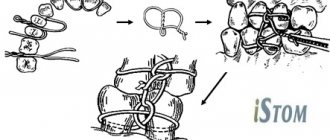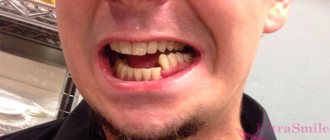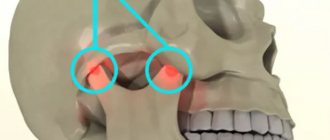Facial injuries are quite common. A jaw bruise is an injury without violating the integrity of the skin and bone tissue.
The main difference between it and a fracture is that the victim is able to close and open his mouth, although this causes serious pain. Only an experienced specialist can identify the problem and carry out differential diagnostics.
Most often, such injuries have a favorable prognosis, but it is necessary to undergo a comprehensive study to exclude possible complications. In addition, you should strictly follow medical recommendations and appear in a timely manner for preventive examinations if necessary.
Pain is the main symptom of injury
Causes of bruises in the maxillofacial area
Most injuries occur unexpectedly and to varying degrees of severity.
Most often they are observed in the following cases:
- falling onto a hard surface;
- due to collision with objects;
- various impacts (road traffic accidents, domestic fights, contact sports).
Falls are the most common causes of injuries to the maxillofacial area
The severity of such injuries largely depends on the affected area, the type of object that affected the bone tissue and age-related changes in facial tissue.
Trauma to the front teeth in a child
The front teeth in children are most often injured. And while injury to other teeth may go unnoticed, injury to a child’s front teeth quickly attracts the attention of parents. An ordinary bruise, in which only a barely noticeable crack in the enamel can be visually seen, may not bother the child in any way. In some cases, there may be discomfort or pain during chewing, or mechanical stress, and slight swelling of the soft tissues.
It’s another matter if, as a result of an injury, a subluxation, dislocation, or even fracture of a tooth occurs. Then the injury to the child’s front teeth is primarily visually noticeable. In the case of subluxation or dislocation, parents may notice an atypical position of the tooth, its slight displacement relative to other teeth. In addition, with this type of injury to the front teeth, bleeding, swelling of the soft tissues, inflammation, severe pain, and mobility of the injured tooth will be noted.
Children often experience fractures of their front teeth. It will be characterized by a violation of the integrity of hard tissues, chipping of a part of the tooth, pain, bleeding, swelling of soft tissues, and hemorrhages in them.
Damage to the lower jaw
This injury is the most common. It occurs in both children, adults and the elderly. The important point is to identify the type of damage as soon as possible and provide first aid. The further prognosis and duration of treatment will depend on this.
A mandibular contusion is a soft tissue injury in the lower parts of the face. As a result, an internal hematoma is formed due to the rupture of small blood vessels.
In the event of a bruise, the bone tissue remains intact and the teeth and gums are not injured. Usually occurs as a result of impact on the maxillofacial area with a blunt object.
Bruise of the jaw after a blow to the lower parts of the face on the left side
The severity of the injury is largely influenced by the moment of impact. Severe consequences are observed with highly tense muscles. In this case, they rupture, forming an extensive hematoma with a pronounced pain reaction.
Main symptoms
Any disease has its own fundamental signs. Symptoms of a bruise of the lower jaw are usually quite striking. The main sign is sharp pain, abrasions, damage to the cheek or lip.
If the blow falls on the area of the dental arch, then gaping wounds form on the soft tissues on the side of the oral cavity. The lower lip looks swollen, sagging and hyperemic.
To make a correct diagnosis, differential diagnosis is necessary. It is important to exclude fractures of the bone areas of the jaw, eye socket and nose.
After a strong blow, the victim should not be left unattended. It is imperative to monitor his general condition. Together with complaints and external examination, a preliminary diagnosis can be established.
In addition to local signs, general manifestations should also be taken into account:
- damage in the form of scratches and hyperemia in the jaw area;
- swelling in the lower part of the face;
- the presence or absence of hematoma of varying volume;
- malaise and swollen lymph nodes;
- sharp or constant pain even at rest;
- impairment in mouth opening, eating and speaking;
- increased pain response from touching the damaged area, as well as movement of the jaw to the left or right side.
Attention!!! The main differential diagnostic sign of a bruise from a fracture is that the jaw bones do not change their anatomical structure. In addition, the line of bone integrity violation can be determined by palpation.
If the injury is severe, the victim must in any case be taken to a doctor for examination to clarify the condition. It is important to carry out rapid transportation with preliminary first aid.
Jaw fracture
This is perhaps one of the most obvious reasons for severe jaw pain. The cause-and-effect relationship between blow - jaw fracture - pain is clear to everyone. Among the first symptoms indicating a fracture rather than a bruise are: unbearable pain, difficulty opening the mouth, malocclusion, swelling, bruising. In this case, immediate contact with an ambulance and maxillofacial surgery is required.
If you feel that your jaw hurts, do not delay in seeing a doctor, as this symptom may be a sign of the onset of a dangerous disease.
You can also read the article “Surgical dentistry”.
Damage to the upper jaw
The nature of injury in this area is more complex. Its danger lies in the fact that serious complications may occur. It is quite easy to distinguish a bruise of the upper jaw from the lower one.
This is determined by the location of the pain and the consequences of trauma. However, it should be taken into account that unpleasant sensations can radiate to the lower part of the face. But the main difference here will be the absence of impaired mobility of the lower jaw.
The symptoms of a bruise of the upper bone tissues are very similar to the previous problem. There is an inflammatory process and pain, swelling, and sometimes enlargement of regional lymph nodes. Even if there are no obvious signs of bruises, you need to go to the clinic.
The photo shows fractures of the upper jaw with severe bruises
The doctor must first rule out a fracture. In the upper jaw, such injuries are dangerous for brain damage.
For example, a Le Fort 3 fracture is a separation of the bones of the skull and face. Without professional medical care, death can occur in this case.
Symptoms
To determine the type and severity of injury, every person should know the first and most common symptoms of a bruise:
- Inflammatory processes in the lymph nodes;
- Formation of swelling of soft tissues;
- Pain during wide opening of the mouth;
- The appearance of scratches and abrasions;
- The occurrence of bruises and hemorrhages;
- Painful sensations localized at the site of injury (in the lower or upper jaw), which can radiate to the ear area and other bones of the skull;
- Inability to perform normal life activities: chew food, yawn, cough or sneeze. When performing such actions, the pain becomes more intense;
- Deterioration of the general condition of the victim.
It is quite simple to distinguish between a regular, superficial bruise and a fracture of the jaw bones: when the integrity of the bone structures is damaged, as a rule, the jaw is deformed, the signs of injury are more pronounced and the integrity of several layers of soft tissue is damaged.
However, to make an accurate diagnosis, it is best to visit the nearest emergency room, where a qualified doctor will conduct the necessary examination procedure and confirm or deny the presence of a fracture, and then prescribe the appropriate treatment in your case.
Diagnostic measures
If minor injuries to the maxillofacial area occur, they do not require contact with a dentist or surgeon, or urgent hospitalization. If there is severe and prolonged pain, the area of damage should be examined by a specialist.
The following are used as diagnostics:
- taking anamnesis;
- general examination by a surgeon, orthopedic dentist, traumatologist;
- special examination by an otolaryngologist, neurologist and other specialized specialists as necessary;
- X-ray examination of the maxillofacial area;
- CT scan;
- analysis of blood, urine, saliva.
Based on the data obtained, a general picture of the victim’s health is formed and a specific treatment is recommended.
The main therapeutic direction will be the following:
- taking painkillers;
- applying a pressure bandage;
- ensuring maximum peace for the victim;
- prescription of physiotherapeutic procedures;
- local and general anesthesia;
- elimination of hematoma and infiltrate.
First aid and treatment of bruises
Ice pack on problem area
Once the location of the damage has been identified, it is necessary to begin simple manipulations. Of course, they will depend on the nature of the damage. If there are open wounds, first of all they must be washed and treated with antiseptic.
Suitable products for this include hydrogen peroxide, Chlorhexidine, Miramistin, Bepanten. Before applying the antiseptic, the wound can be washed with soapy water. The bleeding area must be covered with a clean cloth or, if available, a sterile bandage.
Then apply cold to the affected area through the cloth. This can be an ice pack or a regular towel soaked in cold water, which is applied through a waterproof film.
For severe pain, the following medications are recommended by mouth:
- Analgin;
- Ketorol;
- Nurofen;
- Sedalgin;
- Nise;
- Took;
- Tempalgin;
- Nemesis.
Elements of treatment and means used
Immediately after injury, first aid must be provided. Usually, all bruises of the upper and lower jaw can be treated quite well without medical intervention. However, in case of severe lesions, it is still worth contacting specialists for examination.
Table No. 1. Painkillers:
| Name of the drug | Active substance | Additional action | Mode of application |
| Ketoprofen. | Anti-inflammatory and decongestant. | Apply a thin layer to the skin 2-3 times a day. |
| Ketoprofen. | Anti-inflammatory, improves blood circulation. | Rub the gel until completely dry 2 times a day. |
| Dolgit | Ibuprofen. | Relieves swelling and inflammation. | Apply with gentle massage movements, 3 times a day, up to 3 weeks. |
| Nonivamide, Nicoboxil. | Improves blood circulation, recommended on the 3rd day after injury. | After application, it is recommended to cover the affected area with a warm cloth. |
| Indomethacin | Indomethacin. | Anti-inflammatory. | Children apply no more than 1 cm of gel, adults no more than 15 cm, 2 times a day. |
First of all, cold is applied to the lesion. Low temperatures will help not only relieve swelling and stop bruising, but also provide partial pain relief.
For the most effective elimination of unpleasant sensations, it is necessary to take analgesics internally or apply special ointments externally. Modern drugs are available in the form of gels. They are easy to use, absorb quickly and do not stain clothes.
It is good to use products that contain Heparin. It helps to quickly get rid of infiltration and eliminate the phenomenon of swelling. Heparin-based drugs should not be used by persons with bleeding disorders.
If the gel contains horse chestnut extract, it is contraindicated for people suffering from kidney disease and pregnant women. To prevent side effects from using the gel or ointment, the attached instructions should be studied in any case.
Table No. 2. Coolants:
| Name of the drug | Active substance | Additional action | Mode of application |
| Menthol, methyl salicylate. | Painkillers, anti-inflammatory | Apply in large quantities 3-4 times a day. |
| Aloe vera extract, menthol, camphor, vitamin E. | Quickly relieves pain and has an anti-inflammatory effect. | Apply a thin layer without rubbing. |
| Ketoprofen, Trometamol, essential oils. | Decongestant and painkillers. | Rub in with smooth movements until completely dry. |
| Escin, salicylic acid. | Decongestant, anticonvulsant, painkillers. | Apply with light massage movements, 3-4 times a day, for no more than 14 days. |
The price of medications in the form of gels and ointments ranges from 220 rubles to 350 rubles. One package is completely enough for a course of treatment.
It is difficult to predict when a particular injury will occur. To reduce the risk of bruises and other injuries, precautions should be taken. In winter, move carefully on slippery sidewalks; in summer, when engaging in active sports, think through the possible consequences.
Folk remedies
There are several proven, simple and at the same time effective ways to have the positive effects of alternative medicine. They are indispensable products for pregnant women, children, as well as people who have a severe allergic reaction to medications. You can make a choice based on personal preferences or doctor’s recommendations.
Treatment at home for bruises can be carried out using the following means:
- Table salt solution. Compresses are prepared from it, which are used for any complexity of bruises. To prepare, a tablespoon of salt is dissolved in 150 ml of boiled water. Then take a sterile bandage, soak it in the solution and apply it to the problem area. The compress is covered with a thick cloth on top. The gauze pad with salt can be left overnight.
- Grated potatoes. The tubers should be washed and cleaned first. Grate one tuber on a coarse grater, place in linen cloth and wrap several times. After applying the bruise, cover the top with a thick towel. Compressor exposure time is 30-40 minutes. For best results, make 3-4 applications in a row.
- Cabbage leaf. Before applying it, you should knead it a little or make cuts on it to let the juice out. The sheet is applied to the sore spot 2-4 times a day until it dries completely.
- Onion and garlic. The two ingredients are ground and mixed together. The resulting slurry is added with half a tablespoon of salt; it is recommended to wrap the mixture in gauze and place it in the area of the bruise.
- Beetroot and liquid honey. Finely grated root vegetables are mixed with a tablespoon of natural honey. The procedure is carried out 1-2 times a day for 2 hours.
- Laundry soap. This remedy helps reduce the pain response. The soap is grated and mixed with raw chicken yolk. I apply a compress every half hour up to 6-8 times a day. You can also rub a damp cloth with laundry soap and apply an application to the bruised area.
- Apple vinegar. This is one of the most effective remedies. To prepare the solution, you need to take 2 teaspoons of vinegar and dilute it in 1 liter. water. Soak a clean cloth in the solution and apply 3-4 times a day for half an hour.
Popular folk remedies for bruises
The video in this article shows how to properly apply a warm and cold compress for bruises.
Possible consequences
A bruise is not usually considered a serious injury. However, if you neglect the necessary treatment, unpleasant consequences arise. For example, the result of a bruise of the lower jaw can be a violation of the depreciation of muscle fibers, changes in the cartilage tissue of the joint and a speech defect.
On the muscle side, post-traumatic myositis develops as a complication. It is an inflammatory process, which is subsequently difficult to respond to therapeutic effects.
Attention!!! Bruises of various etiologies often become the cause of the formation of oncological tumors. Timely diagnosis and proper treatment can completely eliminate this complication.
With insufficient attention to the problem, jaw deformation, post-traumatic periostitis and even osteomyelitis occur. Abscesses and phlegmons may form in soft tissues. Such conditions require long-term therapy, with a long recovery period.
Injury to the maxillofacial area is not a trivial matter. It is worth treating this problem with increased attention. Of course, many of them go away on their own. However, ideally any injury should be examined by a medical professional.
What happens if you don’t seek help in time?
- post-traumatic periostitis or inflammation of the periosteum;
- jaw deformation;
- inflammatory process of bone tissue;
- contractures or weakening of joint mobility;
- development of tumor processes (oncology).
Thus, if any mechanical injuries occur in the relevant area, it is imperative to contact a medical facility. The sooner you visit an experienced doctor, the sooner you will eliminate complications and return to a normal lifestyle.









